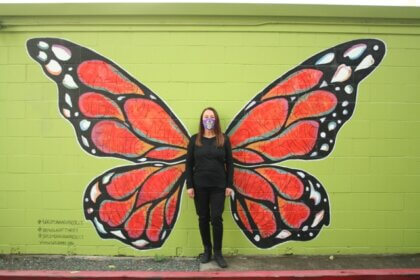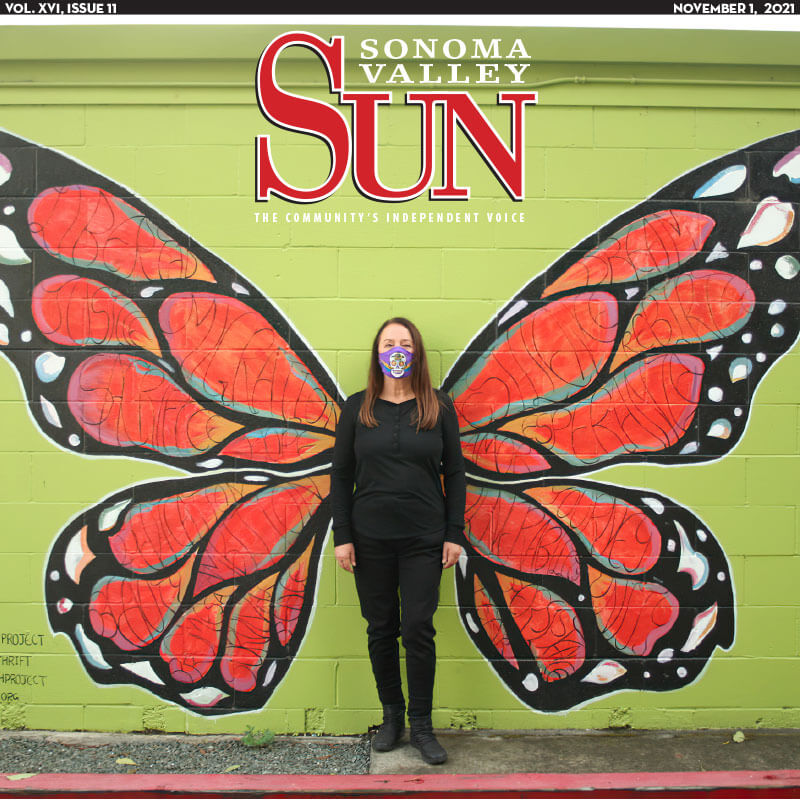
By Loretta Carpio Carr
There’s something about autumn’s darkness and chill that causes us to close ranks and seek shelter from the still melancholy of another year coming to an end.
The festive Thanksgiving and Christmas holidays are ahead, but the period between summer’s finale and the excitement of winter holidays is a mysterious time.
In contrast to the youthfulness of spring, fall has three different observances related to death and the departed: Halloween on October 31, Dia de los Muertos (Day of the Dead) on November 1, and All Souls Day on November 2.
Halloween is generally a children’s holiday, a chance to wear a costume and load up on candy. All Soul’s Day is a Roman Catholic homage to departed souls, but el Dia de los Muertos manages to combine reverence for the dead while celebrating life. In Mexico, the observances can last all three days.
Many of us are familiar with the images of calaveras (skulls), papel picado (decorative paper), and marigolds accompanying candles, photos, and memorabilia offerings to deceased family members at an altar or gravesite tribute, but what is the connection between the beautiful orange and black Monarch butterflies and el Dia de los Muertos?
According to the online group Espiritu Chicano, Monarch butterflies come from the ancient Aztec belief that souls do not die. Mexican folklore believes the butterflies are the souls of our ancestors and loved ones returning to earth to visit and provide comfort.
Millions of butterflies can travel over 2000 miles from Canada to the forests of central Mexico for their winter hibernation. Their late October early November arrival is a highly anticipated time welcomed by large community gatherings amid colorfully decorated cemeteries.
With the significant Mexican population in the United States, these traditions are observed here as well. I learned about the significance of the Monarch when the Sonoma Valley Museum of Art invited community members to submit artistic pieces related to that year’s theme.
In 2006, Sonoma Valley resident Manuel Merjil was the coordinator for the Mariposa (butterfly) themed Dia de los Muertos exhibit. I taught English as a Second Language for Sonoma Adult School at the time. All the classes worked together to create an 18 foot Monarch butterfly.
Some students made dozens of orange, white, or black tissue paper flowers while others tied the flowers to the plastic mesh fencing material. The miraculously huge and beautiful butterfly was generously transported to the museum by a flatbed truck belonging to Norrbom’s Towing.
On opening night, students were thrilled to see their collective creation of honor and respect prominently displayed at the museum entrance. It was a lesson in teamwork as well as artistry, cultural expression, nature, and vocabulary.
Some of us in California have been lucky enough to witness the actual migration of the Monarch through coastal areas of California. The communities of Bolinas and Pacific Grove are among others that work to track and vitalize the Monarch population through their sanctuaries, but sadly, their numbers have drastically decreased in recent years.
In 1997, more than 1.2 million Monarch butterflies were reported along the California coast by the Xerces Society, a conservation organization based in Portland, Oregon. In 2017, 200,000 were counted; in 2019, 29,000 were counted, but in 2020, only 1,900 were found.
The biggest threat is habitat loss and pesticide exposure, according to Xerces. The Sonoma County Farm Bureau has noted the disappearance of butterflies, bees, and other pollinators, which are vital to our food supply.
Those trying to counteract this environmental loss advocate the preservation of pine trees and eucalyptus trees, which provide a natural windbreak, in addition to planting nectar sources.
Fortunately, the latest numbers have improved slightly. Xerces reports that over 1,300 Monarchs were counted at Pacific Grove this October after none were observed at the sanctuary last year. Additional counts in other areas lead conservationists to estimate the number that has arrived to the California coast this year to be around 10,000.
During this shadowy, supernatural season, this alarming decline in the number of Monarchs may hold a message for us – one of extinction.
It could be a message from nature. It could be a message from the spirits.
If we don’t do better to protect our environment and all its living creatures, we may soon be joining los muertos.
Photo: Loretta Carpio Carr, the author, in front of the north wall mural at Republic of Thrift in the Springs.






Members of the Sonoma Farm Bureau, especially pesticide-spewing wine growers, are among those responsible for the now-rapid extinction of the monarch, bees and other insects. Not to mention the polluting and/or draining of any & all water sources, putting it into grapes and beef which are turned into wine and meat and shipped all over the world. The monarch will return only when the brown apple moth does, or when members of the Farm Bureau stop killing them.